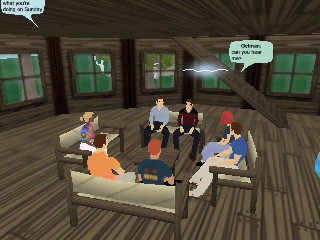
Today I was tasked with the third of our ongoing series of experimental classes. Ostensibly the topic was my 3L paper on asynchronous discussions in the law school classroom, but as the topic is both boring and stale, I decided to try using the time to experiment with testing tools educators often use in the in-person environment. Specifically, I wanted to try using the large group discussion / small group breakout / large group reconvening approach typical of many group trainings. I thought it would be an interesting experiment, or at least change of pace.
Well, of course, a couple of lessons learned:
- Technology is crucial! One of the points I wanted to make substantially, which made itself abundantly clear (though maybe not in the way I had hoped) is that technology can really shape human interactions. Minimal technical proficiency is the first but important hurdle, and using the IM/Chat tool turned out to be a bit of a problem for some… though when it worked, I think it did work.
- With IM/chat, it probably would have been more useful to a larger class — after all, its main purpose in the first place is breaking a large class down into a smaller one. Further, the chats would probably have been more fruitful in groups of 3 or 4, not 2, unlike in a face-to-face situation.
- Interestingly, sitting in a circle made people more reluctant to text-chat as people spoke over voice. We theorized that perhaps the greater feeling of equality made it seem ruder to speak out / over others, while in a lecture format perhaps chatting functions more like passing notes. (Or perhaps our previous or current experiences are just anomalies — after all, this is only our third class!)
I was very glad to have three new people join our circle – Dale Matthews from Oregon State, Colin Rule of eBay, and Ethan Katsch of UMass-Amherst. It was great to have Dale share with us his experiences teaching a film production class in There, and hearing about both his glories and frustrations (some of which, he said, had to do with There not quite “getting” what he was trying to accomplish with teaching). We’re all hoping to sit in on his class in the future.
As for the breakout approach, I think a few of us honed in on the possibility of breaking out into activity rather than discussion groups. There might have been originally built as a glorified chat room, but people in 3D worlds naturally want to do things, not just talk.





{ 1 } Trackback
[…] What’s fascinating to me is that, at least from our experience a few weeks ago, the lecture-style format actually encouraged more cross-chatting in There, in contrast to real life. Or perhaps that’s not entirely a contrast. What I also saw today is that most students are multi-tasking in their chairs. Decades ago students passed notes; in our time, they surf the web and IM (one of my classmates also played Mike Tyson’s Punchout.) In theory, then, students in the relative anonymity of a lecture audience can cross-chat as they would in There, Second Life, or WebEx. In reality, while it was interesting to watch a student look up Charlie Nesson’s Wikipedia entry (today’s topic being wikis), most of the students who were multi-tasking were having personal conversations and keeping up with news or sports. Further, I should qualify that only about half of the class brought laptops, and a good number weren’t using them. […]